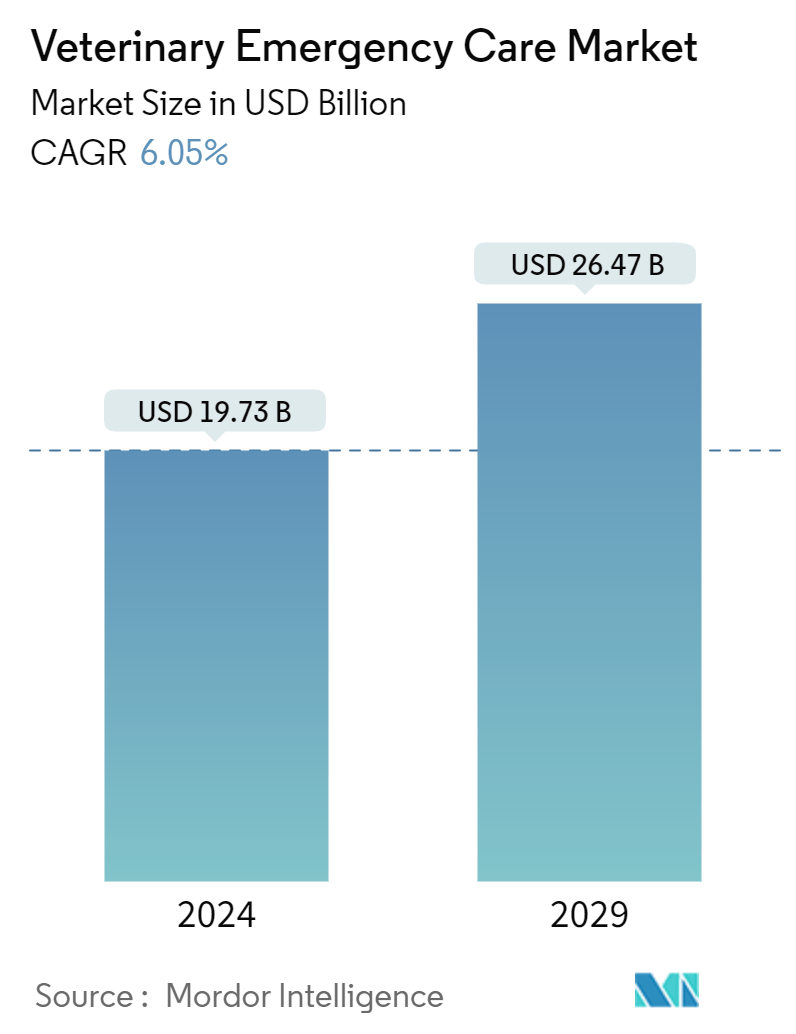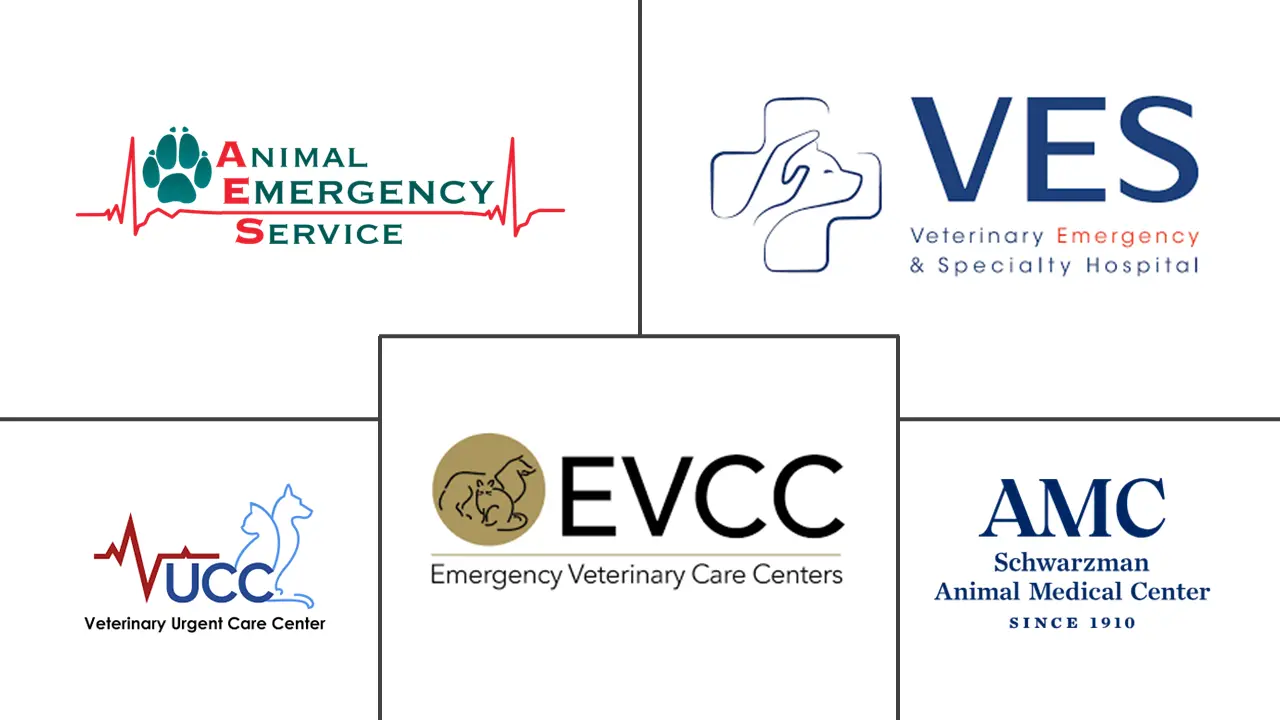Market Size of Veterinary Emergency Care Industry

| Study Period | 2019 - 2029 |
| Market Size (2024) | USD 19.73 Billion |
| Market Size (2029) | USD 26.47 Billion |
| CAGR (2024 - 2029) | 6.05 % |
| Fastest Growing Market | North America |
| Largest Market | Asia Pacific |
| Market Concentration | Low |
Major Players
*Disclaimer: Major Players sorted in no particular order |
Veterinary Emergency Care Market Analysis
The Veterinary Emergency Care Market size is estimated at USD 19.73 billion in 2024, and is expected to reach USD 26.47 billion by 2029, growing at a CAGR of 6.05% during the forecast period (2024-2029).
International collaboration is an emerging strategy in this market. Emerging market players are indulging in partnerships with educational organizations to enhance the skills of veterinarians and address the growing demand for veterinary emergency service care in developing economies. For instance, in December 2022, UW School of Veterinary Medicine, a US organization, announced the introduction of training programs for veterinarians at the Emergency Management and Research Institute (EMRI) in Hyderabad, India. Skilled veterinarians are valuable assets to emergency clinics as each case is time-sensitive. Hence, increasing the availability of skilled veterinarians will likely assist centers in expanding their service offerings and propel overall market growth.
The adoption of new technology enhances efficiency and increases accessibility for pet owners. For instance, in September 2023, a study published by Instinct stated that around 60% of smaller emergency and urgent care hospitals in the United States implemented workflow improvements, while 47% incorporated new imaging/diagnostic technology, and 37% of small veterinary centers in the country got wearable devices. The implementation occurred after a 54% surge in patient volumes, per the State of Emergency and Specialty Veterinary Care report. Although adopting the technologies is likely to reflect on the pricing for pet owners, this strategy is expected to assist veterinary emergency care centers in retaining veterinarians and efficiently managing workload. Improvement in the workflow enhances the speed of the service delivery of the centers and increases the overall veterinary emergency market valuation through better revenue flow.
Increasing collaboration between veterinary groups and the government to address the shortage of emergency care services in emerging countries is considered a vital growth determinant for the market. For instance, in August 2023, the state government of Karnataka, India, launched an emergency helpline number for veterinary service with 290 veterinary ambulances and a team of professionals with each ambulance for rural areas in the state. The government fully sponsors the services offered under this initiative; thus, this service enables the low to middle-income population to avail of the service and expands the market to the under-developed areas of the country.
However, the high cost of emergency veterinary services is estimated to restrain market growth. The high cost reflects high operating expenses, surging prices of medications, and skilled labor.
Veterinary Emergency Care Industry Segmentation
As per the scope of the report, veterinary emergency care is used to address the immediate medical needs of companion and livestock animals.
The veterinary emergency care market is segmented by animal, application, and geography. By animal, the market is segmented into companion animals and livestock animals. By application, the market is segmented into accidental ingestion, respiratory distress, gastrointestinal disease, seizures, accidents, and other applications. By geography, the market is segmented into North America, Europe, Asia-Pacific, the Middle East and Africa, and South America. The market sizes and forecasts are provided in terms of value (USD) for all the above segments.
| By Animal | ||||||
| ||||||
|
| By Application | |
| Accidental Ingestion | |
| Respiratory Distress | |
| Gastrointestinal Disease | |
| Seizures | |
| Accidents | |
| Other Applications |
| Geography | ||||||||
| ||||||||
| ||||||||
| ||||||||
| ||||||||
|
Veterinary Emergency Care Market Size Summary
The veterinary emergency care market is poised for significant growth, driven by increasing pet ownership and the rising demand for emergency services. The market is characterized by international collaborations and partnerships aimed at enhancing the skills of veterinarians, particularly in developing economies. This strategic focus on skill development is crucial as skilled veterinarians are essential for timely and effective emergency care. The adoption of new technologies, such as advanced imaging and diagnostic tools, is also enhancing the efficiency and accessibility of veterinary services, although it may lead to higher costs for pet owners. These technological advancements are expected to improve service delivery speed and contribute to the market's overall valuation.
Regional initiatives and government collaborations are playing a vital role in expanding veterinary emergency care services, particularly in emerging markets. For instance, government-sponsored services in countries like India and Brazil are making emergency care more accessible to low and middle-income populations. Despite the high costs associated with emergency veterinary services, efforts by non-profit organizations and government bodies to bridge the supply-demand gap are expected to support market growth. North America is anticipated to witness substantial growth due to the increasing adoption of pets and the presence of major market players. The market is fragmented, with numerous players expanding their service offerings to include emergency care units, thereby addressing the growing demand and enhancing the accessibility of veterinary emergency services across different economic classes.
Veterinary Emergency Care Market Size - Table of Contents
-
1. MARKET DYNAMICS
-
1.1 Market Overview
-
1.2 Market Drivers
-
1.2.1 Growing Pet Ownership
-
1.2.2 Development of Infrastructure to Facilitate Emergency Care
-
-
1.3 Market Restraints
-
1.3.1 High Out-of-Pocket Cost Associated with the Treatment
-
-
1.4 Porter's Five Forces Analysis
-
1.4.1 Bargaining Power of Suppliers
-
1.4.2 Bargaining Power of Buyers/Consumers
-
1.4.3 Threat of New Entrants
-
1.4.4 Threat of Substitute Products
-
1.4.5 Intensity of Competitive Rivalry
-
-
-
2. MARKET SEGMENTATION (Market Size by Value - USD)
-
2.1 By Animal
-
2.1.1 Companion Animals
-
2.1.1.1 Dogs
-
2.1.1.2 Cats
-
2.1.1.3 Other Companion Animals
-
-
2.1.2 Livestock Animals
-
2.1.2.1 Poultry
-
2.1.2.2 Cattle
-
2.1.2.3 Sheep
-
2.1.2.4 Other Livestock Animals
-
-
-
2.2 By Application
-
2.2.1 Accidental Ingestion
-
2.2.2 Respiratory Distress
-
2.2.3 Gastrointestinal Disease
-
2.2.4 Seizures
-
2.2.5 Accidents
-
2.2.6 Other Applications
-
-
2.3 Geography
-
2.3.1 North America
-
2.3.1.1 United States
-
2.3.1.2 Canada
-
2.3.1.3 Mexico
-
-
2.3.2 Europe
-
2.3.2.1 Germany
-
2.3.2.2 United Kingdom
-
2.3.2.3 France
-
2.3.2.4 Italy
-
2.3.2.5 Spain
-
2.3.2.6 Rest of Europe
-
-
2.3.3 Asia-Pacific
-
2.3.3.1 China
-
2.3.3.2 Japan
-
2.3.3.3 India
-
2.3.3.4 Australia
-
2.3.3.5 South Korea
-
2.3.3.6 Rest of Asia-Pacific
-
-
2.3.4 Middle East and Africa
-
2.3.4.1 GCC
-
2.3.4.2 South Africa
-
2.3.4.3 Rest of Middle East and Africa
-
-
2.3.5 South America
-
2.3.5.1 Brazil
-
2.3.5.2 Argentina
-
2.3.5.3 Rest of South America
-
-
-
Veterinary Emergency Care Market Size FAQs
How big is the Veterinary Emergency Care Market?
The Veterinary Emergency Care Market size is expected to reach USD 19.73 billion in 2024 and grow at a CAGR of 6.05% to reach USD 26.47 billion by 2029.
What is the current Veterinary Emergency Care Market size?
In 2024, the Veterinary Emergency Care Market size is expected to reach USD 19.73 billion.

